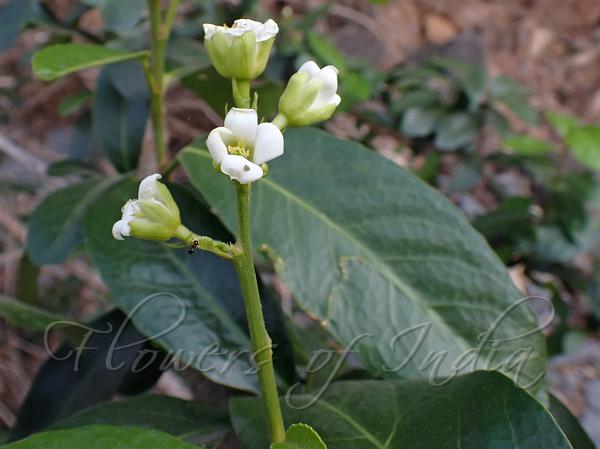|
| Kurnool Tritaxis |
|

|

| File size | 645340 |
| Original date | 3/6/23 4:47 PM |
| Resolution | 4000 x 3000 |
| Flash | Flash did not fire, auto |
| Focal length | 5.4mm |
| Exposure time | 1/500s |
| Aperture | 3.2 |
| Focus Distance | |
| Metering Mode | Multi-segment |
| Camera make | OLYMPUS CORPORATION |
| Camera model | TG-6 |
| Sensor type |
|
|
|
|
Photo: |
Botanical name: Tritaxis kurnoolensis Family: Euphorbiaceae (Castor family)
Synonyms: Dimorphocalyx kurnoolensis
Synonyms: Dimorphocalyx kurnoolensis
Kurnool Tritaxis is a tree, up to 3 m tall, with
branchlets velvet-hairy. It is named for Kurnool district of Andhra
Pradesh where it is predominantly found. Leaves are obovate to
elliptic-inverted-lanceshaped, narrowed or wedge-shaped at base, entire
to faintly wavy along margins, somewhat pointed to blunt or rounded at
tip, 5-19 x 2-6 cm, hairless; lateral nerves 7-12 pairs; leaf-stalks
1-2 cm long; stipules triangular. Male flowers arise in branch-end
stalked cymes; bracts lanceshaped, 3-4 x 1-1.2 mm; flowers nearly
stalkless; sepal-cup appressed hairy outside; sepals nearly round,
about 1 x 1.3 mm. Petals are oblong, often notched, about 8 x 2.5 mm,
disc glands free, ovate-oblate, about 0.6 x 0.8 mm, hairy at top;
stamens have filaments about 1.8 mm long; anthers oblong, about 1.2 mm
across; the inner stamens monadelphous, at the tip of about 7 mm long
staminal column, trifid at tip; anthers round, about 0.8 mm across.
Female flowers are few, in short stalked racemes; flowers 5-8 mm
across; flower-stalks about 2 mm long; sepal-cup shortly 5-lobed;
sepals nearly round, about 2 x 2.5 mm; petals oblong; disc glands as in
male; ovary about 4 x 3 mm, appressed hairy, styles fused at base,
2-fid above. Fruits are almost spherical, depressed, deeply furrowed
between cocci, 1.0-1.3 x 1.3-1.7 cm; fruiting sepals about 5 x 3 mm.
Kurnool Tritaxis is endemic to Andhra Pradesh. Flowering:
November-March.
| Identification credit: Raja Kullayiswamy | Photographed at Owk dam, Andhra Pradesh. |
• Is this flower misidentified? If yes,